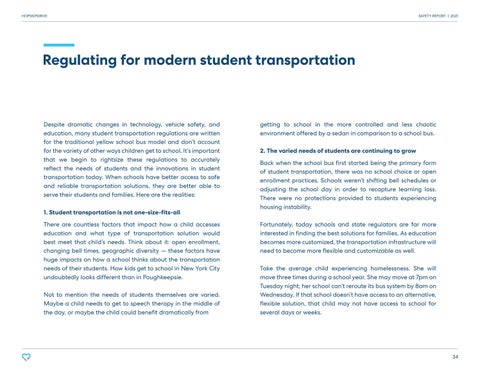HOPSKIPDRIVE
SAFETY REPORT | 2021
Regulating for modern student transportation
Despite dramatic changes in technology, vehicle safety, and education, many student transportation regulations are written for the traditional yellow school bus model and don’t account for the variety of other ways children get to school. It’s important that we begin to rightsize these regulations to accurately reflect the needs of students and the innovations in student transportation today. When schools have better access to safe and reliable transportation solutions, they are better able to serve their students and families. Here are the realities: 1. Student transportation is not one-size-fits-all There are countless factors that impact how a child accesses education and what type of transportation solution would best meet that child’s needs. Think about it: open enrollment, changing bell times, geographic diversity — these factors have huge impacts on how a school thinks about the transportation needs of their students. How kids get to school in New York City undoubtedly looks different than in Poughkeepsie. Not to mention the needs of students themselves are varied. Maybe a child needs to get to speech therapy in the middle of the day, or maybe the child could benefit dramatically from
getting to school in the more controlled and less chaotic environment offered by a sedan in comparison to a school bus. 2. The varied needs of students are continuing to grow Back when the school bus first started being the primary form of student transportation, there was no school choice or open enrollment practices. Schools weren’t shifting bell schedules or adjusting the school day in order to recapture learning loss. There were no protections provided to students experiencing housing instability. Fortunately, today schools and state regulators are far more interested in finding the best solutions for families. As education becomes more customized, the transportation infrastructure will need to become more flexible and customizable as well. Take the average child experiencing homelessness. She will move three times during a school year. She may move at 7pm on Tuesday night; her school can’t reroute its bus system by 8am on Wednesday. If that school doesn’t have access to an alternative, flexible solution, that child may not have access to school for several days or weeks.
34






